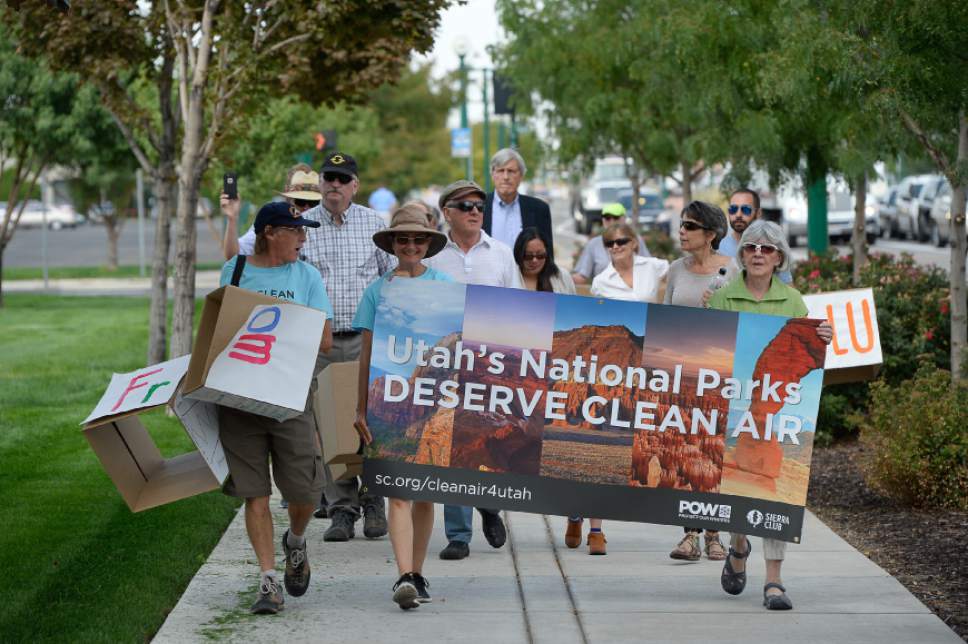This is an archived article that was published on sltrib.com in 2017, and information in the article may be outdated. It is provided only for personal research purposes and may not be reprinted.
A day after it was filed with state regulators, Rocky Mountain Power's latest 20-year strategic plan has come under fire by critics who say elements of the proposal would violate federal law.
The 300-page Integrated Resource Plan, filed Tuesday with the Utah Public Service Commission, selects a "preferred" scenario in which the state's largest electrical utility does not install specific pollution-control systems at its two coal-fired power plants in Utah.
A 2016 decision by the U.S. Environmental Protection Agency requires installation of selective catalytic-reduction systems at Rocky Mountain Power's Hunter and Huntington plants by 2021, part of a long-standing federal effort to reduce regional haze.
Rocky Mountain Power and Utah have sued to challenge the EPA ruling, and Utah Rep. Jason Chaffetz and Sen. Mike Lee last month introduced federal legislation to overturn it.
But until either that bill or the legal challenge reach a conclusion, critics say, the EPA decision remains legally binding and should be part of the company's long-term plans.
"It's baffling Rocky Mountain Power is acting in its future plans as if it can defy federal law, which requires it to reduce Utah's coal power-plant emissions," Matt Pacenza, executive director of the environmental advocacy group HEAL Utah, said in a statement.
A spokesman for Rocky Mountain Power said the company reviewed several scenarios based on legal settlements reached elsewhere in the U.S. It then selected the model without the required pollution controls, according to its filing with state regulators, because it was the cheapest alternative.
The utility's plan acknowledges the uncertain nature of the litigation. And, according to company spokesman David Eskelsen, the report to regulators does not lock in the company's future actions on limiting plant emissions.
As a regulated utility, Rocky Mountain Power is required to submit an Integrated Resource Plan to the Public Service Commission every two years. The report projects demand for electricity for the next 20 years and then lays out how the company plans to meet those needs.
Such plans contemplate various future scenarios, but, typically, Rocky Mountain Power selects the "preferred portfolio" that incurs the least cost and represents the least risk to consumers, Eskelsen said.
"While emissions controls are an important part of our business, they are not resources" that generate electricity, he said. Decisions related to environmental compliance are made via separate processes, he added.
"I don't think it's reasonable to accuse the company of ignoring or thinking we can not comply with the law," Eskelsen said. "The company always complies with the law."
But Gloria Smith, managing attorney at the Sierra Club, said it was unfair for Rocky Mountain Power to ask Utah regulators to evaluate a proposal that would not comply with a clear federal mandate.
It may cost less if the company does not install the required controls, she said, but that option isn't on the table so long as the EPA's order is not halted or overturned.
"The company is obligated to present those expenses to the commission and go from there," she said. "That, to me, is how an honest utility presents things — not wishing things away."
Smith said Rocky Mountain Power's move was unprecedented in her career, adding that she hoped to see the plan corrected by year's end.
The Public Service Commission (PSC) has a specific process in place for resolving such disputes, said Gary Widerburg, the commission's secretary.
Widerburg said the commission welcomed public comment at future hearings on the plan, which may be viewed on either the PSC's website or the Rocky Mountain Power website.
Twitter: @EmaPen



